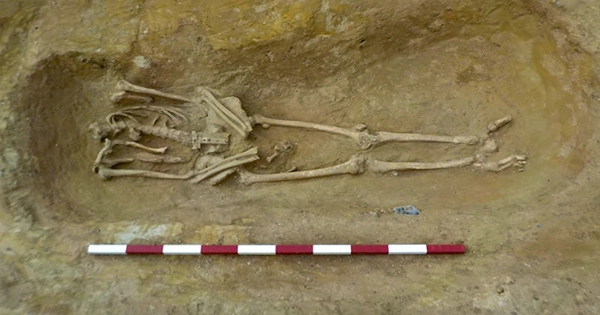In southeast England, a Roman cemetery with 425 skeletons was discovered, with roughly 40 of them decapitated. The cemetery, in Aylesbury in Buckinghamshire, is the county’s largest of its kind, and it’s the latest discovery of the contentious HS2 high-speed rail link project.
Some of the skeletons were discovered with their heads chopped and placed between their legs, a process that archaeologists believe indicates they were criminals or outcasts. They do acknowledge, however, that this was a “typical, if peripheral” burial practice at the period.
Several items, including pins, brooches, and Samian pottery, were discovered with the bodies. Over 1,000 coins, as well as lead weights, were discovered, possibly indicating that this was a center of trade and business 2,000 years ago. Meanwhile, the discovery of gaming dice and bells indicates that the area was once a hotbed of gambling and religious activity.
“The dig is crucial in that it allows for a detailed definition of this Roman town as well as a study of many of its residents,” said Richard Brown, Senior Project Manager for COPA, the firm that hired the HS2 archaeologists. The town in issue is Fleet Marston, which is close to the location where a 1,700-year-old rotten egg was unearthed in a separate excavation. It used to be on each side of Akeman Street, a significant Roman route that ran from Verulamium (now St Albans) to Corinium Dobunnorum (now Cirencester) via Roman Alchester (near Bicester).
The team believes the village was a staging stop for passengers and soldiers on their way to the garrison at Alchester because of its position. This isn’t a one-of-a-kind find. In fact, the site at Fleet Marston is one of more than 100 discovered by HS2 since 2018. The multibillion-dollar initiative, for example, found the bones of explorer Matthew Flinders near Euston, London, in 2019.
“This new site, along with numerous other new Roman habitation sites uncovered during the HS2 construction,” Brown continued, “enhances and populates the map of Roman Buckinghamshire.” The first phase of HS2 is the largest archaeological dig in Europe, spanning 225 kilometers (140 miles) between London and Birmingham. The archaeological discoveries are “an interesting and welcome result,” according to Neil Redfern, director of the Council of Archaeology, who estimates the project will cost £44.6 billion ($60.3 billion) and raise a number of environmental issues.
“Through the HS2 archaeology initiative, we’ve been able to discover more about Britain’s rich history.” “We will be able to obtain a deep insight into the residents of Fleet Marston and the larger Roman Britain landscape thanks to the enormous Roman cemetery at Fleet Marston,” Helen Wass, Head of Heritage at HS2 Ltd, stated. The excavation at Fleet Marston will be investigated over the following few years, giving us a rare glimpse into Roman Britain and the lives of those who lived there.














